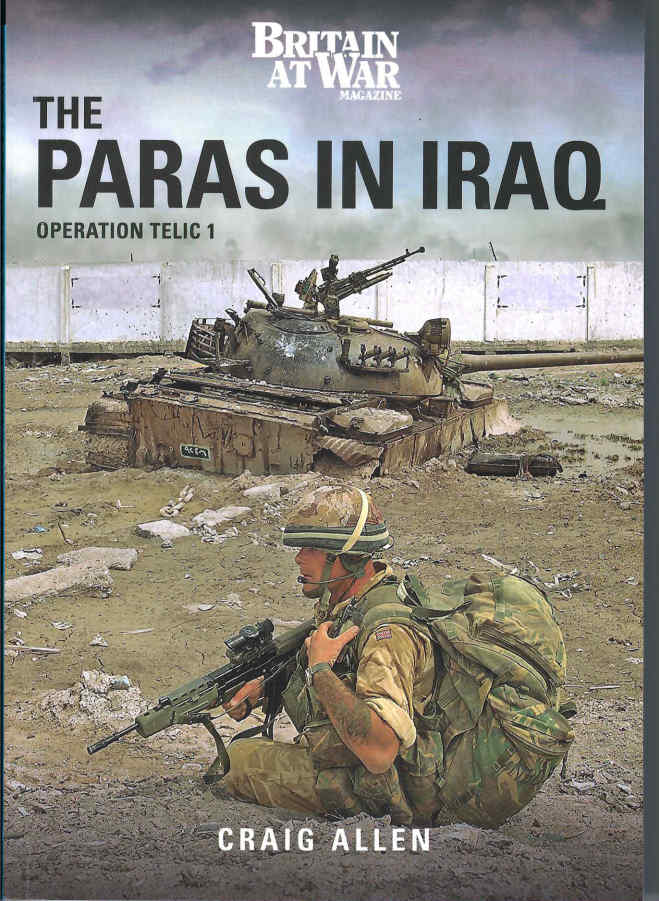The Paras in Iraq, Operation Telic 1
As a former paratrooper and combat veteran of Operation Iraqi Freedom, I was eager to read and review The Paras in Iraq, Operation Telic 1 by Craig Allen. The title of the book is self-explanatory and replete with fantastic photos of first and third battalions of the British Army’s Parachute Regiment in action; first in staging areas in Kuwait, then their move into Basrah and further operations in Baghdad. Knowing a rudimentary history of the British Paras and UK forces in Iraq, I was ready to jump (pun intended) into the book. I was not disappointed.
The author, Craig Allen, writes with the no-nonsense prose of a professional who has seen the elephant of combat. Craig’s true strength is his photography, and it shows in the 128 pages of his book, with only three pages not containing any photographs. If you are looking for a book on the history of the UK involvement in the initial Iraqi 2003 invasion, then you should probably look elsewhere. Craig was a 23-year veteran of the Parachute Regiment, and it reflects in this book. A civilian in 2001, Craig began a new career as a freelance photographer. After the attacks of 9/11, his two worlds merged and in April 2003, he joined 3 Para Battle Group in Kuwait. Craig captures daily life of the Paras in a way only those who have lived that lifestyle can.
The Table of Contents (see accompanying photo) lays out the book in a logical manner, and it is the Prologue on page 4 that sets the book up for its success. In the words of Craig Allen,
“In April of 2003 I joined 3 Para Battle Group; then in Kuwait, and due to my media background, I was given the job of escorting our embedded BBC crew and print journalist. This role gave me the freedom to move around the battlefield and cover the Regiment on operations. The campaign in Iraq proved controversial at home, but for those of us out in the desert the focus was simply on getting the job done. I leave questions of the wisdom of the invasion to historians. This book is simply an attempt to illustrate how paratroopers looked and fought during the campaign and to share my images with a wider audience.”
As an Army veteran, I have developed a critical eye and ear, and could not agree more with Craig’s opening to his book. I was not disappointed as I tore through the book in an afternoon reading the accompanying text. The true strength is Craig’s eye for detail in his photos. We have all most likely seen the staged photos of campaigns and soldiers. Craig photographs the Paras as they were – and the images show professional British Paras doing their tasks with dedication and focus.
For history buffs, this book delves into the basics for anyone who wants to learn more about the UK forces in the early phases of the 2003 Iraq invasion. For modelers, this is a treasure trove of reference material. While Paras are light infantry who can arrive on the battlefield via parachute, one would think the modeling aspects are minimal. Craig did a fantastic job of making modelers’ lives easier by dispelling that notion. His photos are laden with weaponry, destroyed Iraqi implements of war, including the ubiquitous destroyed tanks, personnel carriers, heavy weapons and even some very creative technicals used by the Fedayeen. British armor is represented by the Challenger IIs and Warriors (US is represented with M1 Abrams and M2 Bradleys), that highlights the fact that the heaviest weapons the Paras bring to the fight are M2 heavy machine guns, Milan AT missiles and LAWs (Light Anti-Tank Weapons), mounted on their soft skin vehicles, primarily the WMIK (Weapons Mount Installation Kit) Land Rovers.
While this book is a boon for placing detailed Paras next to destroyed Iraqi armored vehicles, or on patrol with Warriors and Challengers, I truly appreciate the soldier’s aspect of this book. While the differences between American and British English abound (Coys for companies, Crab Air for air transport, etc), the similarities are familiar to anyone who has served, or who want to get more of an insight into deployed soldiers. The section on The Road Home shows Paras loading a Royal Air Force jet for the trip home. A caption reads, “Boarding the plane. The jet age means there is no slow return back to normalcy for returning troops.” This is true beyond measure as modern armies can be in combat one day, then back home among civilians the next. It is a jarring experience for those who have lived it. Gone are the days of rail or boat transport back home, now it is measured in hours.
I would like to meet Craig Allen and thank him in person over a brew or pint for his fantastic The Paras in Iraq, Operation Telic 1 book. I now have visions of British Paras next to destroyed Iraqi armor, or next to a Challenger looking down a Basrah road, or a WMIK ready for patrol, or some Paras in a rooftop sanger overlooking the Tigris River….. At least I know he has another book I want to find, With the Paras in Helmand.
Profuse thanks to Casemate and IPMS/USA for providing the review sample.

















Comments
Add new comment
This site is protected by reCAPTCHA and the Google Privacy Policy and Terms of Service apply.
Similar Reviews